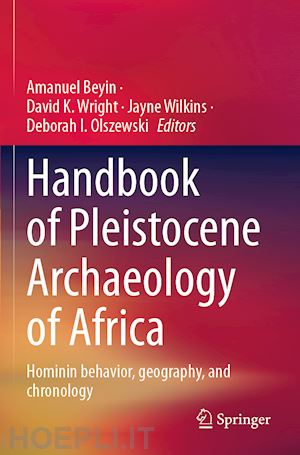

Questo prodotto usufruisce delle SPEDIZIONI GRATIS
selezionando l'opzione Corriere Veloce in fase di ordine.
Pagabile anche con Carta della cultura giovani e del merito, 18App Bonus Cultura e Carta del Docente
This handbook showcases an Africa-wide compendium of Stone Age archaeological sites and methodological advances that have improved our understanding of hominin lifeways and biogeography in the continent. The focal time spans the Pleistocene Epoch (c. 2.5 million–11,700 years ago) during which important human traits, such as obligate bipedalism that freed the hands to engage in creative activities, a large brain relative to body size, language, and social complexity, developed in the general forms that they are found today. The handbook is the first of its kind, and it is expected to play a significant role in human evolutionary research by:
? Collating the African Stone Age record, which exists in a fragmented state along the lines of national boundaries and colonial experiences.
? Showcasing emerging conceptual and methodological advances in African Pleistocene archaeology.
? Providing reference datasets for teaching and researching African prehistory.
? Making Africa’s Stone Age record accessible to researchers and students based in Africa who may not have access to journal publications where most new field discoveries are published.
The Handbook features 128 chapters, of which 116 are site entries grouped by the host countries and presented in an alphabetical order. A number of those site-related entries examine multiple archaeological localities lumped under specific projects or study areas. The rest of the contributions deal with methodological topics, such as luminescence and radiocarbon dating, field data recovery, lithic analysis, micromorphology, and hominin fossil and zooarchaeological records of Pleistocene Africa. The introductory chapter provides an historical overview of the development of Stone Age (Paleolithic) archaeology in Africa beginning in the mid-19th century, and paleoenvironmental and chronological frameworks commonly used to structure the continent’s Pleistocene record. By making a good amount of AfricanStone Age literature accessible to researchers and the public, we wish to promote interest in human evolutionary research in the continent and elsewhere.Section 1: Recent methodological advances.- Section 2: North-West Africa.- Section 3: Northeast Africa.- Section 4: Central-East Africa.- Section 5: Southern Africa.- Section 6: What does the future hold for Pleistocene Archaeology of Africa.- Concluding thoughts by editors.
Amanuel Beyin (Associate Professor of Anthropology, University of Louisville, USA). Broadly trained in African prehistory, Beyin’s research interests lie in hominin dispersal history out of Africa, the cultural dimensions of human evolution with a focus on stone tool technology, and the role of coastal habitats in hominin survival. He has conducted original archaeological fieldwork in the Red Sea coastal areas of Eritrea and the Sudan, Turkana Basin (Kenya) and the Kilwa coast of Tanzania. Beyin received his B.A. from the University of Asmara (Eritrea), and M.A. and Ph.D. from Stony Brook University (New York, USA).
David K. Wright (Professor of Archaeometry in the Department of Archaeology, Conservation and History, University of Oslo, Norway). Wright is a geoarchaeologist/environmental archaeologist with a specialty in geochronology and paleoenvironments. He has worked in Tsavo National Park and Lake Turkana, Kenya; the Benoué River Valley, Cameroon; and the Karonga region of northern Malawi. Wright received his B.A. from Wayne State University (Detroit, USA), and M.A. and Ph.D. from the University of Illinois at Chicago (USA).
Jayne Wilkins (Research Fellow, Australian Research Centre for Human Evolution, Griffith University, Australia, and Research Associate, Human Evolution Research Institute, University of Cape Town, South Africa). Wilkins’ research seeks to understand the origins and behavioral innovations of Homo sapiens through archaeological excavation, stone tool analysis, and experimental archaeology. She has excavated at several archaeological sites across southern Africa, including Pinnacle Point on the south coast, and Ga-Mohana Hill and Kathu Pan in the southern Kalahari Basin. Wilkins received her B.Sc degrees and M.A. from the University of Calgary (Canada), and Ph.D. from the University of Toronto (Canada).
Deborah I. Olszewski (Adjunct Professor of Anthropology, University of Pennsylvania, USA, and Consulting Scholar, University Museum of Archaeology and Anthropology, University of Pennsylvania, USA). Olszewski’s research focuses on the Stone Age Archaeology of northern Africa, the Middle East, and Europe. She has directed field projects in Jordan, Egypt, Sudan, and Morocco, focusing on sites dating between c. 500,000 and 11,700 years ago, with a particular emphasis on lithic analysis and settlement patterning. She received her B.A. from Colorado State University in Ft. Collins, and M.A. and Ph.D. from the University of Arizona in Tucson (USA).











Il sito utilizza cookie ed altri strumenti di tracciamento che raccolgono informazioni dal dispositivo dell’utente. Oltre ai cookie tecnici ed analitici aggregati, strettamente necessari per il funzionamento di questo sito web, previo consenso dell’utente possono essere installati cookie di profilazione e marketing e cookie dei social media. Cliccando su “Accetto tutti i cookie” saranno attivate tutte le categorie di cookie. Per accettare solo deterninate categorie di cookie, cliccare invece su “Impostazioni cookie”. Chiudendo il banner o continuando a navigare saranno installati solo cookie tecnici. Per maggiori dettagli, consultare la Cookie Policy.